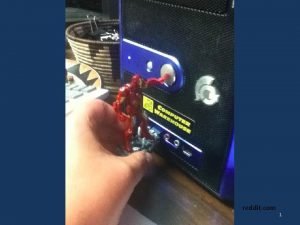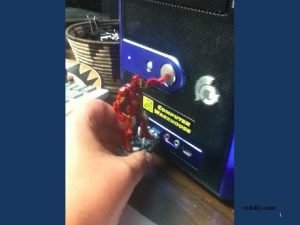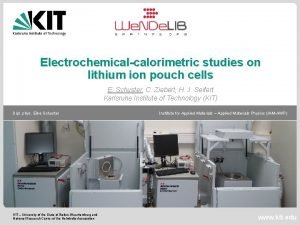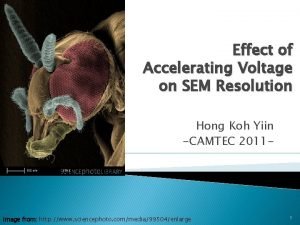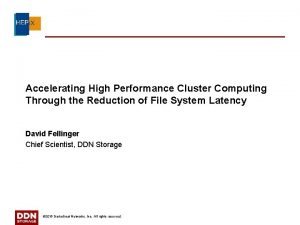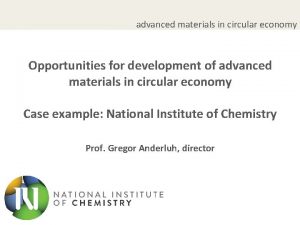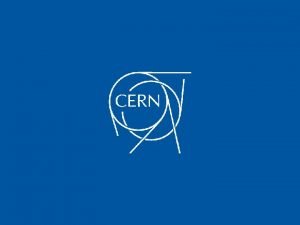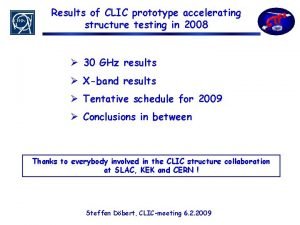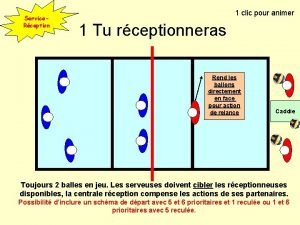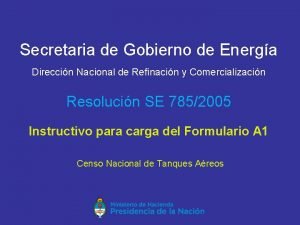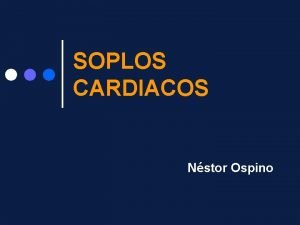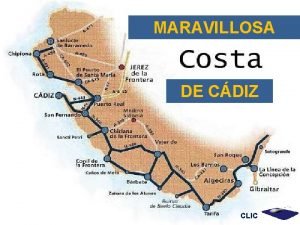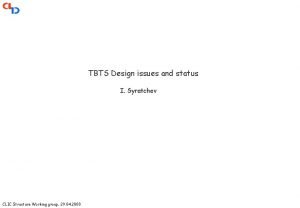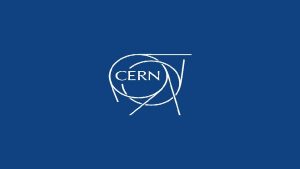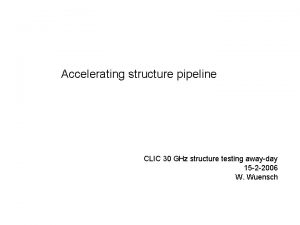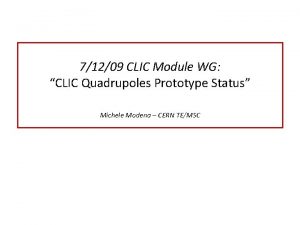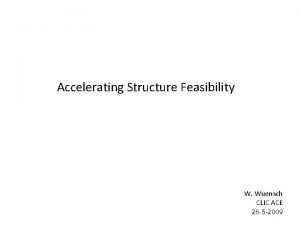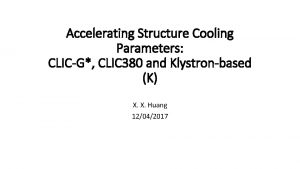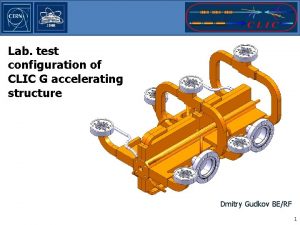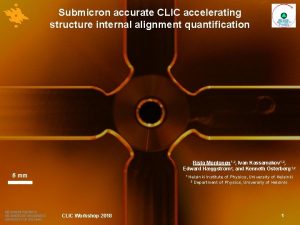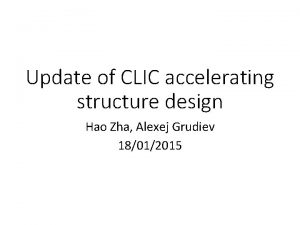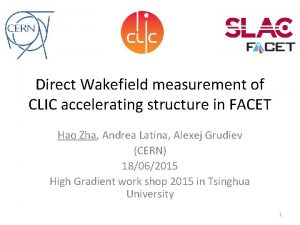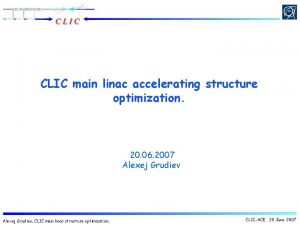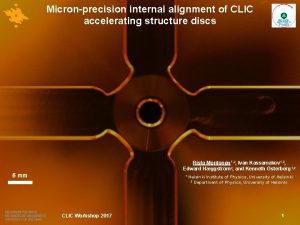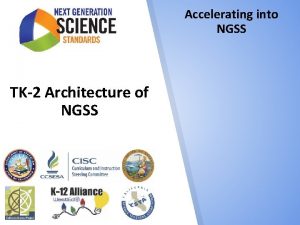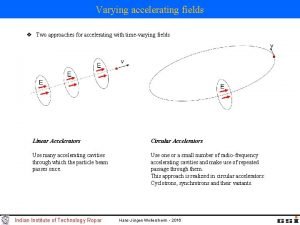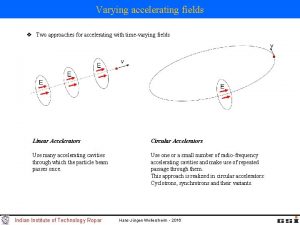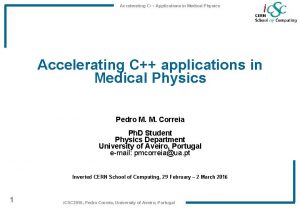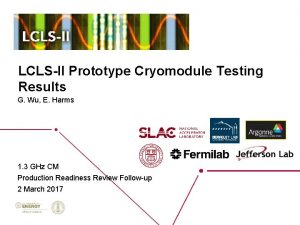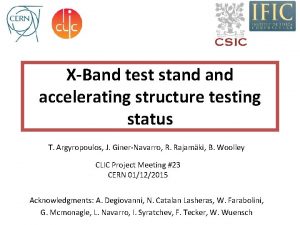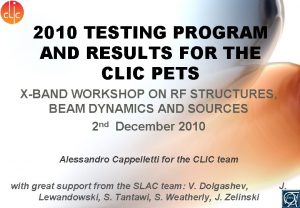Results of CLIC prototype accelerating structure testing in




















![T 18_vg 2. 6_disk [2] tested at KEK Identical preparation as T 18_vg 2. T 18_vg 2. 6_disk [2] tested at KEK Identical preparation as T 18_vg 2.](https://slidetodoc.com/presentation_image/9846be2ed3d90940ce6c773035da6f57/image-21.jpg)


![T 18_vg 2. 6_disk [5] made by CERN, tested at SLAC CERN-made disk structure: T 18_vg 2. 6_disk [5] made by CERN, tested at SLAC CERN-made disk structure:](https://slidetodoc.com/presentation_image/9846be2ed3d90940ce6c773035da6f57/image-24.jpg)

















- Slides: 41

Results of CLIC prototype accelerating structure testing in 2008 Ø 30 GHz results Ø X-band results Ø Tentative schedule for 2009 Ø Conclusions in between Thanks to everybody involved in the CLIC structure collaboration at SLAC, KEK and CERN ! Steffen Döbert, CLIC-meeting 6. 2. 2009

30 GHz Structures tested in 2008 Only two… • HDS 4_thick : re-test, bad results. Didn’t reach an accelerating gradient much higher than 60 MV. m-1. • C 30 speed bump : same geometry as the older 3. 5 mm structure except for a « speed bump » lowering the group velocity at the input. Two measurements : fed by the input and by output. 2 Mathias Gerbaux - CTF 3 Collaboration Technical meeting - 27/01/2009

HDS 4_thick re-test: whole history In total : 1, 244, 800 pulses, mainly at 1 Hz corresponding to 5. 76 SLAC hours at 60 Hz but crappy data 3 Mathias Gerbaux - CTF 3 Collaboration Technical meeting - 27/01/2009

C 30 -sb In total : • 4, 101, 250 pulses, mainly at 1 Hz corresponding 18. 99 due SLAC Weirdto things to hours at 60 Hz calibration problems • 2186 breakdowns (now solved) 4 Mathias Gerbaux - CTF 3 Collaboration Technical meeting - 27/01/2009

30 GHz speed bump results

30 GHz conclusions Ø HDS 4_thick did not work as expected even so designed using ‘new’ theories Technology (quadrants) doubted rather then theory Ø Speed bump did not show an influence on breakdown rate vs gradient Ø 30 GHz experiments will end in 2009 to focus on 12 GHz One more structure (TM 02) will be tested after start up Ø Nevertheless the 30 GHz test stand will not be dismantled in 2009

X-band structures tested in 2008 Ø HDX 11 repolished and heat treated at 1000 deg C Ø T 18_vg 2. 6_disk [1], [2] and [5] (2009) Ø T 28_vg 2. 9_disk Ø TD 18_vg 2. 4_quad Ø PETS (will not be mentioned) TD 18_vg 2. 4_quad T 18_vg 2. 6_disk Steffen Döbert, CLIC-meeting 6. 2. 2009 T 28_vg 2. 9_disk

HDX 11 retesting Electro-polished Brazed at 1000 deg Better alignment Chris Adolphsen

Faya Wang

HDX 11 retesting Chris Adolphsen

Structure parameters Rf parameters along the structure for T 18 and T 28 design TD 28_vg 3 TD 18_vg 2. 4 75 35 Structure design aimed for low group velocity, small aperture and low input power

T 18_vg 2. 6_disk Collaboration between KEK, SLAC and CERN Design by CERN, fabrication by KEK, surface prep. , bonding and testing at SLAC Frequency: 11. 424 GHz Cells: 18+2 matching cells Filling Time: 36 ns Length: active acceleration 18 cm Iris Dia. a/λ 0. 155~0. 10 Group Velocity: vg/c 2. 6 -1. 0 % Phase Advace Per Cell 2π/3 Power for <Ea>=100 MV/m 55. 5 MW Unloaded Ea(out)/Ea(in) 1. 55 Es/Ea 2 Second structure with identical preparation currently under test at KEK

Conditioning history of T 18_disk Faya Wang

Conditioning history of T 18_disk Short pulse higher gradient condition Pulse shape dependence BKD study. BKD pulse width dependence study at 110 MV/m. BKD gradient dependence study at 230 ns pulse width

T 18_vg 2. 6_disk results CLIC goal: trip rate < 3 10 -7/m

Long term operation t-2 fit à~ factor 50 -100 improvement during conditioning (5 -10 observed during NLC/GLC R&D)

Break down distribution along the structure Bead pull Structure seems to be ‘limited’ at the end where the fields are highest

T 18_vg 2. 6_disk backwards Conditioning history Structure was turned around and tested shortly again to see at which level the output cell would be limited

T 18_disk, backward vs forward àgiven the very different conditioning times and strategies a very consistent result Confirms that T 18_disk was ‘limited’ by its last cell

T 18_vg 2. 6_disk backwards Break down distribution Almost all the breakdowns are in the first (former last) cell post mortem endoscope inspection showed mainly damage between the last regular iris and the matching iris
![T 18vg 2 6disk 2 tested at KEK Identical preparation as T 18vg 2 T 18_vg 2. 6_disk [2] tested at KEK Identical preparation as T 18_vg 2.](https://slidetodoc.com/presentation_image/9846be2ed3d90940ce6c773035da6f57/image-21.jpg)
T 18_vg 2. 6_disk [2] tested at KEK Identical preparation as T 18_vg 2. 6_isk [1], only difference are the high power rf flanges T. Higo and S. Matsumoto

Recent 253 ns processing and 80 MV/m run Processing to 90 MV/m. Stable run at 80 MV/m. Most of the trips are due to klystron related matter. We are off-line analysed. Processing to 110 MV/m. 12/4/2008 X-band WS in UL 2008

Processing summary till late Nov. • Processing reached up to 253 ns, 90 MV/m – 1000 BD’s in 650 hours • Breakdown rate – <1 BD/15 hr ~ <2 x 10 -6 BD/pulse/m 80 MV/m, 213 ns just after processing ~ 2 x 10 -6/m • Dark current – Toward upstream 5~10 m. A – Toward downstream 20 ~30 m. A – Field enhance factor around 40~60 • Our strategy – stay at 253 ns, 80 MVm for a month – then restart processing to 100 MV/m and higher Rumors: ~ 2 x 10 -5/m 12/4/2008 X-band WS in UL 2008 T. Higo and S. Matsumoto
![T 18vg 2 6disk 5 made by CERN tested at SLAC CERNmade disk structure T 18_vg 2. 6_disk [5] made by CERN, tested at SLAC CERN-made disk structure:](https://slidetodoc.com/presentation_image/9846be2ed3d90940ce6c773035da6f57/image-24.jpg)
T 18_vg 2. 6_disk [5] made by CERN, tested at SLAC CERN-made disk structure: manufacturing procedures and assembly strategy is different, Structure not leak tight therefore tested in a tank, Assembled at SLAC

RF process history of T 18 Disk_CERN RF process history of T 18 Quad RF process history of T 18 Disk_SLAC

TD 18_vg 2. 4_quad Same rf parameter as T 18_disk but HOM damping Structure made out of 4 milled bars

Surface Preparation, brazing and assembly done at SLAC identical to disk structures

TD 18_vg 2. 4_quad, results ~ 9. 2 10 -4/m 1000 Breakdowns after 25 hours Structure shows poor performance at low gradient and short pulse length, strong outgasing

TD 18_vg 2. 4_quad, results clear difference in breakdown location compared to disk structure therefore likely different limitation mechanism compared to disk version

T 28_vg 3. 3_disk Structure Type L (cm) Total Acc. Cells vg % c 2 a mm T mm r MW/m t Qave Tf ns Even Cell Of T 53 VG 3 26 30 3. 30 -1. 62 7. 8 -6. 3 1. 66 92 -107 0. 19 6843 35. 8 Structure entirely made by SLAC using NLC T 53 cells Juwen Wang

T 28, conditioning history (a) The average unloaded gradient. (b) normalized breakdown rate.

T 28, breakdown position 0~250 hrs 250~500 hrs Similar to T 18_disk behavior, breakdowns prefer the end of the structure

T 28, trip rate vs gradient Average gradient Peak gradient factor 10 more breakdowns for same average gradient but in terms of peak gradient not very different performance

Structure comparison Peak gradient smaller apertures (group velocities) sustain higher surface fields

Testing Conclusions Ø We basically reached our first milestone (100 MV/m unloaded with good break down rate and pulse length without damping and optimum efficiency) Ø Damping is the next important milestone Ø Disk technology gives clearly better performance, if done right (T 18_quad might be limited by damping features) Ø It seems that the result is reproducible too Ø Very high temperature treatment and baking does not make the difference Ø T 28 results unexpected (not ‘limited’ by first cell) but not inconsistent Ø Tapering (surface field, power flow ? ), did we go to far in T 18 What is really limiting this structure ? Ø New T 24 vg 1. 7_disk seems still to be the right structure for the next step towards a prototype CLIC structure

Mile stones and decision points 100 MV/m average gradient for CLIC pulse length with good breakdown rate and acceptable efficiency > 10 % Similar performance with damping CDR Similar performance, damping, better efficiency ‘CLIC prototype structure T 24 vg 1. 7’ Fully featured structure HOM loads and s-BPM’s integrated (ASSET test ? ) Review manufacturing technology, optimization strategy, baseline geometry, rf parameters Review damping options and parameter optimization

Tentative Structure testing program

Testing Program Conclusions Ø We did less structures than originally planned Ø CERN has to sort out its manufacturing procedures (a task force is currently working out a strategy to do so) Ø If we have to wait for SLAC/KEK made T 24’s we most likely get our ‘CLIC Prototype’ milestone only in 2010 Ø CLIC X-Band collaboration works great and is essential !

The END

Structure parameters Name T 24_vg 1. 8_disk T 18_vg 2. 6_disk TD 18_vg 2. 4_quad TD 18_vg 2. 4_disk Name 11 WNSDGCu 11 WNSDvg 1 Cu 11 WDSQvg 1 Cu 11 WDSDvg 1 Cu N cell 24 18 18 18 3. 307/2. 467 4. 06/2. 66 1. 82/0. 93 2. 61/1. 02 2. 41/0. 92 2. 24/0. 87 59 36 39 41 Pin unloaded (MW) (100 MV/m) (only regular cells) 42. 9 53. 9 55. 5 58. 1 Pin unloaded (MW) (100 MV/m) (full structure) 44. 2 55. 5 57. 3 60. 0 3. 72*10^9 312 312 Nrf 6 8 8 8 Pin loaded (MW) (100 MV/m) (only regular cells) 54 61. 7 63. 6 66. 4 Pin loaded (MW) (100 MV/m) (full structure) 55. 7 63. 7 65. 6 68. 5 Pulse length (ns) 236. 8 267. 4 272. 9 276. 4 P/c (Wu) 14. 7 15. 0 15. 5 16. 2 Efficiency (%) (no coupler included) 30. 5 17. 7 16. 8 15. 9 ain, out (mm) Vgin/out Tfilling (ns) (full structure) Bunch population: N Number of bunches/train

Parameters of new structure TD 24 vg 1. 7 Structure TD 24 vg 1. 7 Frequency: f [GHz] 12 Average iris radius/wavelength: <a>/λ 0. 11 Input/Output iris radii: a 1, 2 [mm] 3. 15, 2. 35 Input/Output iris thickness: d 1, 2 [mm] 1. 67, 1. 00 N. of reg. cells, str. length: Nc, l [mm] 24, 229 Bunch separation: Ns [rf cycles] 6 Luminosity per bunch X-ing: Lb× [m-2] 1. 22× 1034 Bunch population: N 3. 72× 109 Number of bunches in a train: Nb 312 Filling time, rise time: τf , τr [ns] 62. 9, 22. 4 Pulse length: τp [ns] 240. 8 Input power: Pin [MW] 63. 8 Pin/Ct. Pp 1/3[MW/mm ns 1/3] 18 Max. surface field: Esurfmax [MV/m] 245 Max. temperature rise: ΔTmax [K] 53 Efficiency: η [%] 27. 7 Figure of merit: ηLb× /N [a. u. ] 9. 1
 Horizontal prototype
Horizontal prototype Prototype 1 or 2 reddit
Prototype 1 or 2 reddit Accelerating rate calorimeter
Accelerating rate calorimeter The law of accelerating returns
The law of accelerating returns Effect of accelerating voltage on sem resolution
Effect of accelerating voltage on sem resolution Accelerated implementation methodology
Accelerated implementation methodology Accelerating high performance
Accelerating high performance Advanced materials
Advanced materials Control structure testing in software testing
Control structure testing in software testing Prototype structure
Prototype structure Prototype structure
Prototype structure Oxford english testing.com
Oxford english testing.com Oh grand saint nicolas
Oh grand saint nicolas Double entry sales invoice
Double entry sales invoice Palabras con v
Palabras con v Dead clic
Dead clic 1 clic reception
1 clic reception Sgda 785
Sgda 785 Clic paris emeraude
Clic paris emeraude Mesosistolico
Mesosistolico Clic
Clic Imagenes de clic
Imagenes de clic Clic
Clic Cern clic
Cern clic Clic sequr citoyen
Clic sequr citoyen Alphabet etrusque
Alphabet etrusque Rey orozco
Rey orozco Domain testing in software testing
Domain testing in software testing Logic based testing
Logic based testing Du path testing
Du path testing Positive negative testing
Positive negative testing Cs 3250
Cs 3250 Globalization testing in software testing
Globalization testing in software testing Functional testing vs unit testing
Functional testing vs unit testing Language testing
Language testing Decision table testing in software testing
Decision table testing in software testing Decision table technique
Decision table technique Error yang dapat diketahui dari pengujian black box adalah
Error yang dapat diketahui dari pengujian black box adalah Behavior testing adalah
Behavior testing adalah Decision table based testing
Decision table based testing Rigorous testing in software testing
Rigorous testing in software testing Testing blindness in software testing
Testing blindness in software testing
